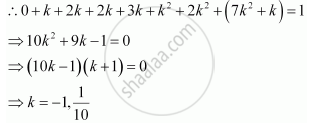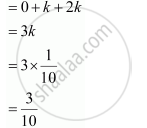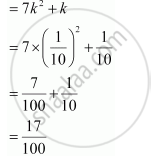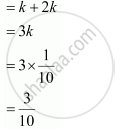Advertisements
Advertisements
Question
A random variable X has the following probability distribution.
| X | 0 | 1 | 2 | 3 | 4 | 5 | 6 | 7 |
| P(X) | 0 | k | 2k | 2k | 3k | k2 |
2k2 |
7k2 + k |
Determine
(i) k
(ii) P (X < 3)
(iii) P (X > 6)
(iv) P (0 < X < 3)
Solution
(i) It is known that the sum of probabilities of a probability distribution of random variables is one.

k = − 1 is not possible as the probability of an event is never negative.
`:.k = 1/10`
(ii) P (X < 3) = P (X = 0) + P (X = 1) + P (X = 2)

(iii) P (X > 6) = P (X = 7)

(iv) P (0 < X < 3) = P (X = 1) + P (X = 2)

APPEARS IN
RELATED QUESTIONS
State the following are not the probability distributions of a random variable. Give reasons for your answer.
| Y | -1 | 0 | 1 |
| P(Y) | 0.6 | 0.1 | 0.2 |
Find the probability distribution of the number of successes in two tosses of a die, where a success is defined as
(i) number greater than 4
(ii) six appears on at least one die
The random variable X has probability distribution P(X) of the following form, where k is some number:
`P(X = x) {(k, if x = 0),(2k, if x = 1),(3k, if x = 2),(0, "otherwise"):}`
- Determine the value of 'k'.
- Find P(X < 2), P(X ≥ 2), P(X ≤ 2).
Suppose that two cards are drawn at random from a deck of cards. Let X be the number of aces obtained. Then the value of E(X) is
(A) `37/221`
(B) 5/13
(C) 1/13
(D) 2/13
An urn contains 25 balls of which 10 balls bear a mark ‘X’ and the remaining 15 bear a mark ‘Y’. A ball is drawn at random from the urn, its mark is noted down and it is replaced. If 6 balls are drawn in this way, find the probability that
(i) all will bear ‘X’ mark.
(ii) not more than 2 will bear ‘Y’ mark.
(iii) at least one ball will bear ‘Y’ mark
(iv) the number of balls with ‘X’ mark and ‘Y’ mark will be equal.
Two numbers are selected at random (without replacement) from the first five positive integers. Let X denote the larger of the two numbers obtained. Find the mean and variance of X
Two numbers are selected at random (without replacement) from positive integers 2, 3, 4, 5, 6 and 7. Let X denote the larger of the two numbers obtained. Find the mean and variance of the probability distribution of X.
Two cards are drawn successively with replacement from a well shuffled pack of 52 cards. Find the probability distribution of the number of kings.
An urn contains 4 red and 3 blue balls. Find the probability distribution of the number of blue balls in a random draw of 3 balls with replacement.
A fair die is tossed twice. If the number appearing on the top is less than 3, it is a success. Find the probability distribution of number of successes.
From a lot of 10 bulbs, which includes 3 defectives, a sample of 2 bulbs is drawn at random. Find the probability distribution of the number of defective bulbs.
Find the mean and standard deviation of each of the following probability distribution:
| xi : | 1 | 3 | 4 | 5 |
| pi: | 0.4 | 0.1 | 0.2 | 0.3 |
A discrete random variable X has the probability distribution given below:
| X: | 0.5 | 1 | 1.5 | 2 |
| P(X): | k | k2 | 2k2 | k |
Find the value of k.
Three cards are drawn at random (without replacement) from a well shuffled pack of 52 cards. Find the probability distribution of number of red cards. Hence, find the mean of the distribution .
A random variable has the following probability distribution:
| X = xi : | 1 | 2 | 3 | 4 |
| P (X = xi) : | k | 2k | 3k | 4k |
Write the value of P (X ≥ 3).
A random variable X has the following probability distribution:
| X : | 1 | 2 | 3 | 4 | 5 | 6 | 7 | 8 |
| P (X) : | 0.15 | 0.23 | 0.12 | 0.10 | 0.20 | 0.08 | 0.07 | 0.05 |
For the events E = {X : X is a prime number}, F = {X : X < 4}, the probability P (E ∪ F) is
If X is a random-variable with probability distribution as given below:
| X = xi : | 0 | 1 | 2 | 3 |
| P (X = xi) : | k | 3 k | 3 k | k |
The value of k and its variance are
A die is tossed twice. A 'success' is getting an even number on a toss. Find the variance of number of successes.
For the following probability density function (p. d. f) of X, find P(X < 1) and P(|x| < 1)
`f(x) = x^2/18, -3 < x < 3`
= 0, otherwise
Using the truth table verify that p ∨ (q ∧ r) ≡ (p ∨ q) ∧ (p ∨ r).
The following data gives the marks of 20 students in mathematics (X) and statistics (Y) each out of 10, expressed as (x, y). construct ungrouped frequency distribution considering single number as a class :
(2, 7) (3, 8) (4, 9) (2, 8) (2, 8) (5, 6) (5 , 7) (4, 9) (3, 8) (4, 8) (2, 9) (3, 8) (4, 8) (5, 6) (4, 7) (4, 7) (4, 6 ) (5, 6) (5, 7 ) (4, 6 )
Find mean and standard deviation of the continuous random variable X whose p.d.f. is given by f(x) = 6x(1 - x);= (0); 0 < x < 1(otherwise)
Three different aeroplanes are to be assigned to carry three cargo consignments with a view to maximize profit. The profit matrix (in lakhs of ₹) is as follows :
| Aeroplanes | Cargo consignments | ||
| C1 | C2 | C3 | |
| A1 | 1 | 4 | 5 |
| A2 | 2 | 3 | 3 |
| A3 | 3 | 1 | 2 |
How should the cargo consignments be assigned to the aeroplanes to maximize the profit?
If X ∼ N (4,25), then find P(x ≤ 4)
The following table gives the age of the husbands and of the wives :
| Age of wives (in years) |
Age of husbands (in years) |
|||
| 20-30 | 30- 40 | 40- 50 | 50- 60 | |
| 15-25 | 5 | 9 | 3 | - |
| 25-35 | - | 10 | 25 | 2 |
| 35-45 | - | 1 | 12 | 2 |
| 45-55 | - | - | 4 | 16 |
| 55-65 | - | - | - | 4 |
Find the marginal frequency distribution of the age of husbands.
The probability that a bomb dropped from an aeroplane will strike a target is `1/5`, If four bombs are dropped, find the probability that :
(a) exactly two will strike the target,
(b) at least one will strike the target.
Determine whether each of the following is a probability distribution. Give reasons for your answer.
| y | –1 | 0 | 1 |
| P(y) | 0.6 | 0.1 | 0.2 |
A pair of dice is thrown 3 times. If getting a doublet is considered a success, find the probability of two successes
There are 10% defective items in a large bulk of items. What is the probability that a sample of 4 items will include not more than one defective item?
The probability that a bulb produced by a factory will fuse after 200 days of use is 0.2. Let X denote the number of bulbs (out of 5) that fuse after 200 days of use. Find the probability of (i) X = 0, (ii) X ≤ 1, (iii) X > 1, (iv) X ≥ 1.
Solve the following problem :
Following is the probability distribution of a r.v.X.
| X | – 3 | – 2 | –1 | 0 | 1 | 2 | 3 |
| P(X = x) | 0.05 | 0.1 | 0.15 | 0.20 | 0.25 | 0.15 | 0.1 |
Find the probability that X is positive.
Solve the following problem :
The probability that a component will survive a check test is 0.6. Find the probability that exactly 2 of the next 4 components tested survive.
Solve the following problem :
A computer installation has 3 terminals. The probability that any one terminal requires attention during a week is 0.1, independent of other terminals. Find the probabilities that 1 terminal requires attention during a week.
A discrete random variable X has the probability distribution given as below:
| X | 0.5 | 1 | 1.5 | 2 |
| P(X) | k | k2 | 2k2 | k |
Find the value of k
Let X be a discrete random variable whose probability distribution is defined as follows:
P(X = x) = `{{:("k"(x + 1), "for" x = 1"," 2"," 3"," 4),(2"k"x, "for" x = 5"," 6"," 7),(0, "Otherwise"):}`
where k is a constant. Calculate the value of k
The probability distribution of a discrete random variable X is given as under:
| X | 1 | 2 | 4 | 2A | 3A | 5A |
| P(X) | `1/2` | `1/5` | `3/25` | `1/10` | `1/25` | `1/25` |
Calculate: Variance of X
If the p.m.f of a r. v. X is
P(x) = `c/x^3`, for x = 1, 2, 3
= 0, otherwise
then E(X) = ______.
